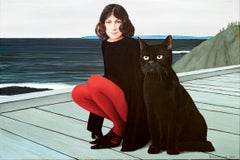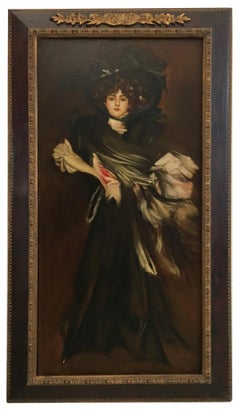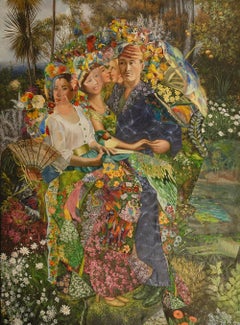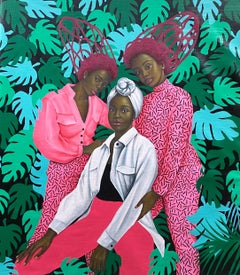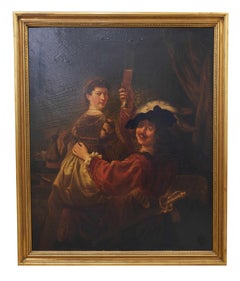Oversized Portrait Paintings
1880s Realist Animal Paintings
Oil
2010s Realist Figurative Paintings
Cotton Canvas, Acrylic
Early 2000s Italian School Figurative Paintings
Canvas, Oil
2010s Contemporary Portrait Paintings
Canvas, Mixed Media, Acrylic
21st Century and Contemporary Expressionist Portrait Paintings
Canvas, Oil, Acrylic
Late 19th Century Dutch School Portrait Paintings
Canvas, Oil
1970s Feminist Figurative Paintings
Canvas, Acrylic
21st Century and Contemporary Contemporary Portrait Paintings
Canvas, Acrylic
Early 20th Century Impressionist Landscape Paintings
Canvas, Oil
1970s Impressionist Figurative Paintings
Oil
21st Century and Contemporary Surrealist Figurative Paintings
Linen, Oil
21st Century and Contemporary Contemporary Portrait Paintings
Canvas, Acrylic
Early 19th Century Old Masters Portrait Paintings
Canvas, Oil
Mid-20th Century Impressionist Portrait Paintings
Canvas, Oil
1830s Old Masters Portrait Paintings
Oil
1930s Modern Figurative Paintings
Paint, Oil, Wood Panel
20th Century Modern Portrait Paintings
Canvas, Oil
18th Century Old Masters Paintings
Oil
Late 20th Century Post-Impressionist Portrait Paintings
Canvas, Acrylic
21st Century and Contemporary Contemporary Portrait Paintings
Canvas, Oil
21st Century and Contemporary Contemporary Portrait Paintings
Canvas, Acrylic
Early 18th Century Portrait Paintings
Oil
2010s Contemporary Figurative Paintings
Canvas, Charcoal, Acrylic
Early 2000s American Modern Figurative Paintings
Oil, Paint
1950s Figurative Paintings
Canvas, Oil
2010s Contemporary Portrait Paintings
Linen, Oil
21st Century and Contemporary Contemporary Portrait Paintings
Canvas, Charcoal, Acrylic
21st Century and Contemporary Contemporary Figurative Paintings
Canvas, Acrylic
Mid-20th Century Futurist Portrait Paintings
Mixed Media, Board, ABS
Late 17th Century Rococo Portrait Paintings
Oil
20th Century Expressionist Portrait Paintings
Oil, Board
1910s Cubist Portrait Paintings
Canvas, Oil, Panel
2010s Realist Figurative Paintings
Cotton Canvas, Acrylic
2010s Contemporary Figurative Paintings
Canvas, Oil
21st Century and Contemporary Contemporary Portrait Paintings
Canvas, Mixed Media, Oil, Acrylic
2010s Realist Portrait Paintings
Canvas, Oil
21st Century and Contemporary Contemporary Figurative Paintings
Canvas, Acrylic
1980s Pop Art Portrait Paintings
Canvas, Acrylic
19th Century Academic Figurative Paintings
Canvas, Oil
Artist Comments
Three figures in colorful dresses stand gracefully amidst a lush, fantasy garden. Oversized flowers in soft pastel tones add a surreal feel to the scene. The ...
21st Century and Contemporary Contemporary Figurative Paintings
Oil
Mid-17th Century Baroque Figurative Paintings
Canvas, Oil
1930s Animal Paintings
Canvas, Oil
2010s Contemporary Figurative Paintings
Canvas, Oil
16th Century Old Masters Paintings
Oil
16th Century Old Masters Figurative Paintings
Oil
1970s Impressionist Portrait Paintings
Canvas, Oil
21st Century and Contemporary Expressionist Portrait Paintings
Canvas, Acrylic
2010s Realist Portrait Paintings
Oil, Board
2010s Impressionist Portrait Paintings
Canvas, Oil
21st Century and Contemporary Pop Art Portrait Paintings
Canvas, Oil
19th Century Realist Portrait Paintings
Oil
Early 20th Century Symbolist Figurative Paintings
Canvas, Oil
1920s Art Deco Portrait Paintings
Oil
20th Century Realist Portrait Paintings
Oil
21st Century and Contemporary Photorealist Portrait Paintings
Canvas, Oil
Early 2000s Realist Figurative Paintings
Oil, Canvas
1840s Victorian Portrait Paintings
Canvas, Oil
21st Century and Contemporary Surrealist Figurative Paintings
Canvas, Acrylic
1870s Baroque Portrait Paintings
Gold Leaf
21st Century and Contemporary Expressionist Figurative Paintings
Canvas, Oil, Acrylic
Read More
Cecilia Vicuña Merges Politics, Science and Spirituality in Her Poetic Art
The Chilean creator, who has been living in exile in New York for decades, is having a major moment, receiving the biggest exhibitions, commissions and awards an artist could dream of.
In Christopher Spitzmiller’s New York Homes, His Love of Dogs Is on Full Display
The ceramist, designer and gentleman farmer tells us about the collection of antique dog art he has spread across a New York City apartment and a Greek Revival farmhouse in the Hudson Valley.
This Wiener Werkstätte Master Made Everything into Art
Koloman Moser smashed the conservative conventions of art and design in fin-de-siècle Vienna. On the 100th anniversary of his death, the Austrian designer is being celebrated for his radically modern creations.

